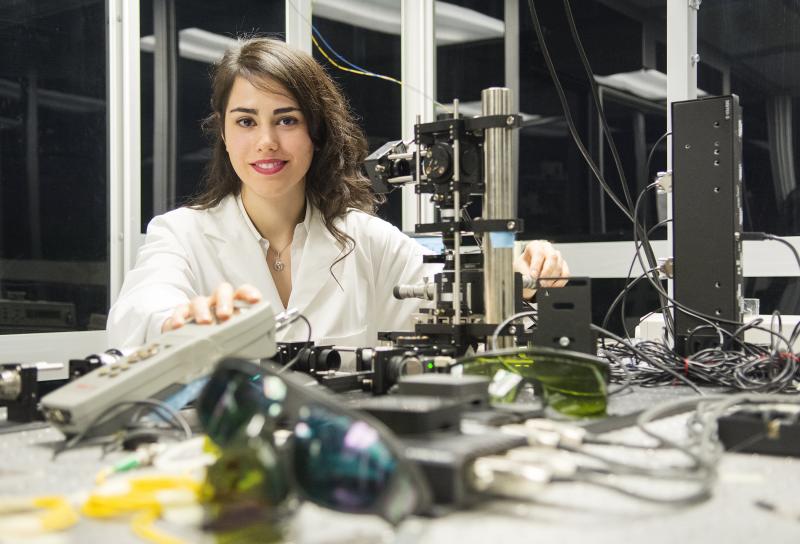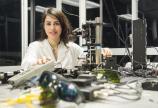Engineering grad casts new light on nanoscale interactions
- Julie Sloan

Researchers all over the world dream of making new discoveries in well-established fields, but engineering grad Ana Zehtabi-Oskuie’s path has gone straight to the edge of an emerging field. While studying Electrical Engineering at the University of Tehran, Zehtabi-Oskuie became intrigued by optical trapping, a method pioneered in 2009 by electrical engineering professor Dr. Reuven Gordon, a team of UVic grad students and Dr. Romain Quidant at the Europe-based Institute of Photonic Sciences.
Zehtabi-Oskuie describes optical trapping as the use of light and nanomaterials “to trap very small particles, on a nano scale, to move, manipulate and study them.” She knew that it was the field for her, combining her desire to work in electrical engineering and her love of chemistry. And UVic’s Nanoplasmonics and Optronics Lab was where Zhetabi-Oskuie knew she was headed.
When Zehtabi-Oskuie started research for her thesis in Gordon’s lab, optical trapping was done with molecules in one medium—water. She has since developed a new technique to better isolate and study individual protein molecules and their interactions. This groundbreaking work means that by using optical trapping, researchers can now look at and manipulate, for example, how a protein binds with a virus. Her research has far-reaching implications, extending well beyond health care research. Zehtabi-Oskuie’s work has attracted the interest of industry partners in optics and pharmaceuticals. Thorlabs, the world’s largest optics supplier, sponsored a web-based video about her work.
Zehtabi-Oskuie credits Gordon for a great deal of this success. “Dr. Gordon has tons of new ideas every day. I was just the person to implement them.” The admiration goes both ways. As Gordon explains, “I have had many excellent researchers in my group. While these students are all highly intelligent and dedicated, what sets Zehtabi-Oskuie apart is her exceptional professionalism in accomplishing her research goals. I think this will play a big role in her future success.”
And Zehtabi-Oskuie seems to be successful wherever she goes. She completed an eight-month co-op work term with Blackberry in 2013, during which time she was the primary inventor for a near field communication (NFC) patent.
While overcoming technological hurdles has been Zehtabi-Oskuie’s specialty, she found moving so far from home and family to be a big personal challenge. Fortunately, three of her friends from Tehran also came to UVic’s engineering program, and two of her brothers have since moved to Victoria, which has made a big difference for her.
Zehtabi-Oskuie will receive the Lieutenant Governor’s Silver Medal during June convocation for her thesis: Microfluidic Integration of a Double-Nanohole Optical Trap with Applications. Her work has been published in four international peer-reviewed journals and she has given talks at two international conferences. Her papers have been rapidly adopted by the scientific community as well, receiving 14 citations in just over a year.
So what’s next for Zehtabi-Oskuie? She has her eye on post-doc research, hopefully at the Argonne National Laboratory, one of the most prestigious science and engineering research centres in the world. Given what she’s accomplished so far, it’s likely we’ll be hearing more about Ana Zehtabi-Oskuie in the future.
——
More about optical trapping: http://communications.uvic.ca/releases/release.php?display=release&id=1082
More student stories from Spring convocation: http://ring.uvic.ca/news/congratulations-spring-2014-grads

